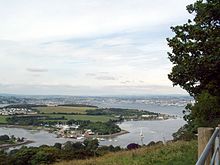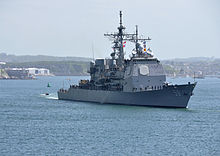|
Her Majesty's Naval Base (HMNB) Devonport (formerly HMS Drake), is one of three operating bases in the United Kingdom for the Royal Navy (the others being HMNB Clyde and HMNB Portsmouth). HMNB Devonport is located in Devonport, in the west of the city of Plymouth in Devon, England. It is the largest naval base in Western Europe and is the sole nuclear repair and refuelling facility for the Royal Navy. The co-located Royal Dockyard is owned and operated by the Marine division of Babcock International Group (BM), who took over the previous owner Devonport Management Limited (DML) in 2007. The BM operation is commonly called Devonport Royal Dockyard.
In 2009 the Ministry of Defence announced the conclusion of a long-running review of the long-term role of three naval bases. Devonport will no longer be used as a base for attack submarines after these move to Faslane by 2017, and the next generation of frigates will be based at Portsmouth. However, Devonport retains a long-term role as the dedicated home of the amphibious fleet and survey vessels.
HM Naval Base Devonport is the home port of the Devonport Flotilla which includes the largest ship in the Royal Navy HMS Ocean and the Trafalgar-class submarines.
History
In 1588, the ships of the English Navy set sail for the Spanish Armada through the mouth of the River Plym, thereby establishing the military presence in Plymouth. Sir Francis Drake is now an enduring legacy in Devonport, as the naval base has been named HMS Drake.
In 1689 Prince William of Orange became William III and almost immediately he required the building of a new dockyard. The town of Plymouth he dismissed as inadequate. Edmund Dummer a Naval Officer travelled the West Country searching for an area where a dockyard could be built; he sent in two estimates for sites, one in Plymouth, Cattewater and one further along the coast, on the Hamoaze, a section of the River Tamar, in the parish of Stoke Damerel. On 30 December 1690, a contract was let for a dockyard to be built in the Hamoaze area, which was the start of the Devonport Royal Dockyards.
At Devonport, Dummer was the designer of the first successful stepped stone dry dock in Europe. Previously the Navy Board had relied upon timber as the major building material, which resulted in high maintenance costs and was also a fire risk. The docks Dummer designed were stronger with more secure foundations and stepped sides that made it easier for men to work beneath the hull of a docked vessel. These innovations also allowed rapid erection of staging and greater workforce mobility. He discarded the earlier three-sectioned hinged gate, which was labour intensive in operation, and replaced it with the simpler and more mobile two-sectioned gate. He wished to ensure that naval dockyards were efficient working units that maximised available space, as evidenced by the simplicity of his design layout for Devonport (which then was known as Plymouth Dock, not to be confused with the nearby town of Plymouth). He introduced a centralised storage area and a logical positioning of buildings, and his double rope-house combined the previously separate tasks of spinning and laying while allowing the upper floor to be used for the repair of sails. The nearby Royal William Victualling Yard was established in Stonehouse in the mid-18th century for supplying the Royal Navy but is no longer in military use and is now open to the public.
Today
Devonport Dockyard and the Hamoaze from the Rame Peninsula, Cornwall.
The Royal Navy Dockyard consists of 14 dry docks (Docks Numbered 1 to 15, but there is no 13 Dock), four miles (6 km) of waterfront, 25 tidal berths, five basins and an area of 650 acres (2.6 kmē). It is the base for the Trafalgar-class nuclear-powered hunter killer submarines and the main refitting base for all Royal Navy nuclear submarines. Work was completed by Carillion in 2002 to build a refitting dock to support the Vanguard-class Trident missile nuclear ballistic missile submarines.
Locals and tourists have long been able to visit the Dockyard during "Navy Days", a two-day event where visitors can tour the facility, go aboard active naval ships and watch various displays of naval prowess. Among the most popular attractions is the nuclear-powered submarine HMS Courageous, used in the Falklands War.
USS Philippine Sea visiting Devonport pictured right.
Devonport serves as headquarters for the Flag Officer Sea Training, which is responsible for the training of all the ships of the Navy and Royal Fleet Auxiliary, along with many from foreign naval services.
The Devonport Naval Heritage Centre is a maritime museum in Devonport Historic South Yard.
No.2 Wharf and No.3 Wharf has been passed over to Devonport Yachts, for the construction of superyachts.
Nickname
The Naval base at Devonport is nicknamed "Guz" by naval ratings. One suggestion is that this originates from the word guzzle (to eat or drink greedily), which is likely to refer to the eating of cream teas, a West Country delicacy and, therefore, one with strong connections to the area around Plymouth.[9] Another explanation advanced is that "GUZZ" was the call sign for the nearby Royal Navy wireless station,(which was GZX), at Devil's Point, though this has been disputed.
|